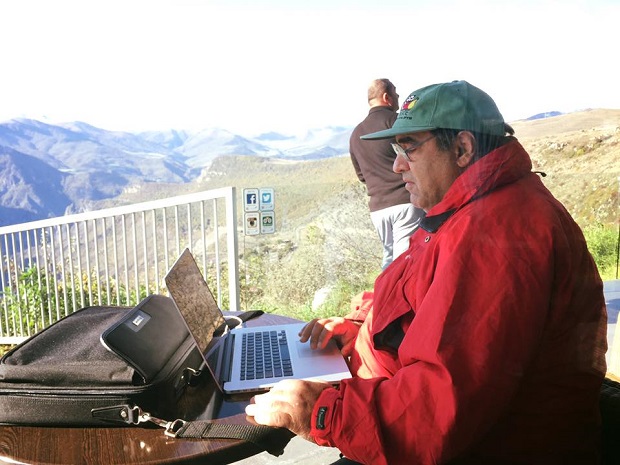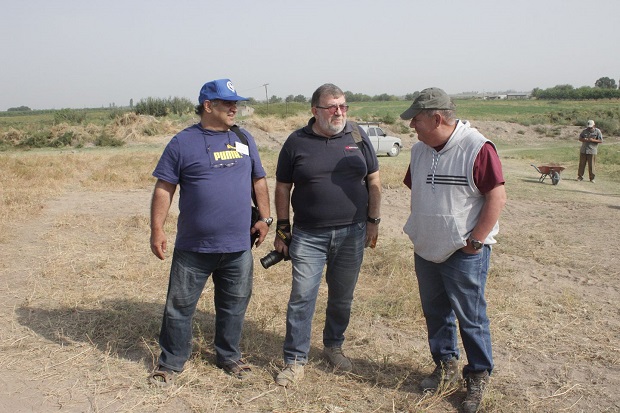
Armenian scientist offers a method of 'diagnosing' earthquakes
It is impossible to predict an earthquake in the short term, and to date, this point of view remains dominant in seismology. That is, it is impossible to determine with a sufficient degree of accuracy the place, time, and strength of an earthquake.
Geologist Armen Ghazaryan, who has long worked in Norway, Canada, and Angola and now returned to Armenia, says earthquakes can be "diagnosed" and this is very important for Armenia, which is one of the most earthquake-prone countries in the world.

In light of the recent increase in seismic activity in the region, NEWS.am TECH decided to seek a comment from the expert. On October 5 and 10, three earthquakes with magnitudes of 5.5, 5.1, and 4.8 were registered in Iran, and on October 11 an earthquake with a magnitude of 4.9 occurred in Turkey. In February 2011 the same activity was observed in Armenia - on February 5 and 13 earthquakes with magnitude 4.7 followed by aftershocks occurred.
Armenia is an earthquake-prone country
As the scientist explained, Armenia is considered an earthquake-prone country for the reason that the whole population is exposed to seismic danger and the construction in the country is not enough seismic-resistant. Strong earthquakes are not as frequent here as, say, in Japan, so for the next generation, they become something that has been and gone, a history, which dulls vigilance and reduces the level of preparedness to resist the elements. At the same time Japan, for example, is ready for earthquakes at any moment and its entire population knows what to do at that time.
Armen Ghazaryan continued the joint research begun in 1978 by a group of scientists from the Institute of Geological Sciences of the National Academy of Sciences of Armenia and the Vernadsky Institute of Geochemistry and Analytical Chemistry. Vernadsky Institute of Geological Sciences of Armenia and on this basis proposed a new method of diagnostics of an earthquake.
To test the method he needs some equipment, a good team, and several years of work. Even though the stereotype about the impossibility to predict earthquakes is deeply rooted in the world, the leadership of the Institute of Geological Sciences of NAS RA decided to give the scientist a place and an opportunity to test his method.
The dominant point of view
As the scientist explained, the statements of supporters of the point of view that earthquakes are impossible to predict (and its apologist is Robert Geller) are based on the fact that randomness and influence of numerous external factors play a great role in the process of earthquake source preparation. Therefore, Geller considers this process as close to chaotic processes as possible. According to him, the strength of an earthquake does not depend on the force that generates this earthquake, therefore, it is impossible to predict it.
Geller's summary is as follows: a strong earthquake is an unstoppable weak earthquake. And since there are many weak earthquakes, it is impossible to say which of them will develop into a strong one.
What is the basis of the method proposed by Armen Ghazaryan?
Usually, when forecasting earthquakes, the assumption is that the coming earthquake must have a harbinger. They look for it in the form of a certain anomaly, a burst of indicators, and, as a rule, just before the catastrophe. Comparing the data of geochemical parameters of water taken from three observation stations in Armenia (Ararat, Kajaran, Surenavan) Armen Ghazaryan found out that the harbinger is not a surge but the calmness, and it occurs 4,5 months before the event. Normally, he said, water readings change daily. And in 4.5 months, the water readings stop changing. It turns out there is a signal in the water of an impending earthquake. When the lull begins, and it coincides with the local maximum of helium in the water, you can say there will be a period of seismic hazard in 4.5 months.
"So it's not a spike in the anomaly just before an earthquake, but the lull before the storm," he said.
The geologist looked at several large earthquakes that have occurred in the region in different years -- Narman (Turkey, 1983), Spitak (Armenia, 1988), and Rudbar (Iran, 1992) -- and found that the same phenomenon occurred in all three cases.
"These are different earthquakes, of different magnitudes. And we get the prognostic sign at the same time. And that was a breakthrough because it meant that nature repeated itself. That is, if we create a network, we can know in 135 days when where, and of what magnitude an event will occur. And in that time we can rebuild an entire city," he said.
After getting these data, the scientist also plotted the number of earthquakes as a function of the time of day over the entire observation period. Several peaks appeared on the graph - one around noon. It turned out that seismic activity has periodicity and is related to planetary, not mantle phenomena. That is, strong earthquakes can be associated with lunar and solar cycles. The periodicity turned out to be 24 and 12 hours and 28 and 14 days.
Further analysis of the data, according to the scientist, showed that an earthquake is a rising process and that the force acting on the epicenter is quadratic (not linear, as Geller claims).
"The idea that strong earthquakes are randomly developed weak earthquakes does not stand up to criticism. A strong earthquake differs from a weak earthquake in that it has a long lifespan. So we can find it in advance," said Armen Ghazaryan.
He noted that an earthquake is the end of a certain process and if we follow the whole process, we will see when it is over. It is not even a question of predicting an earthquake, but a diagnosis: will there be an earthquake or not?
"If we create a network of wells and collect statistics for 2.5 years based on data in several measuring points, we can calculate the time (with an accuracy of several days), the place (with an accuracy of several kilometers), and the strength of the earthquake," he said.

What is needed to start the project?
According to Armen Ghazaryan, he needs to install at least 12 stations (two networks of 6 to overlap each other) with normal automation, which sends information to the data processing center in the existing wells in Armenia.
He assembles these stations with his own hands with the support of his friends who live in different countries. Some of the stations are now ready and can be installed, but, according to Armen Ghazaryan, the network must be state-owned to be trusted. The Institute of Geological Sciences has provided him with a place to work and the boreholes should be monitored by the Territorial Seismic Protection Service of the Armenian Ministry of Emergency Situations. Now Armen Ghazaryan is establishing cooperation between the Institute, the Seismic Protection Service, and other structures, which should be involved in the project implementation process.
"There is an understanding that we need to unite and do this. After all, if there is a strong earthquake, we could all die," he noted.
Action Plan in case of a possible earthquake
It's one thing to forecast an earthquake, but the second thing is to work out a plan of action: How will the government react to it? Armenia is located in a seismic active zone and the forecast of earthquakes should be regarded as one of the state priorities, it is an issue of national security.
If it manages to prove that the methodology works, it is already a task of civil defense. Based on the diagnosis, it will be possible to take preventive measures: stock up on food, water, and medicines, prepare shelters and temporary camps, prepare medical facilities and doctors, replenish blood supplies, train the population, cancel mass events, close educational institutions, vacate roads, remove construction equipment from the city. So that immediately after the earthquake we can begin to eliminate the consequences of the earthquake.
Regional network
By the way, Armen Ghazaryan told his idea to his Georgian colleagues in Tbilisi as well, who showed great interest in it. If we manage to put the same stations in Georgia and try to involve Iran as well, we can build a regional network, he noted.
- Most read
month
week
day
- Huge battery, IP68/IP69K and MIL-STD-810H certifications: Ulefone will present the Armor Pad 3 Pro tablet (photo) 928
- How will new technologies change future of finance? Interview with director of Apricot Capital (video) 734
- 5 original buildings with curious optical illusions (photos) 731
- 10 most interesting architectural works of Zaha Hadid 723
- What risks do crypto and digital currencies pose? Interview with Rasmus Nielsen 697
- WhatsApp will get new and useful feature 623
- 4 flares erupted from Sun in rare event: the Earth may be hit by geomagnetic storm (video) 621
- Date of new Apple presentation known: When will they show us new iPad Pro with OLED screen? 608
- Mutated bacteria resistant to drugs found on the ISS: What does this mean and why is it a problem? 607
- Android 15 to get two useful new features 600
- Archive
